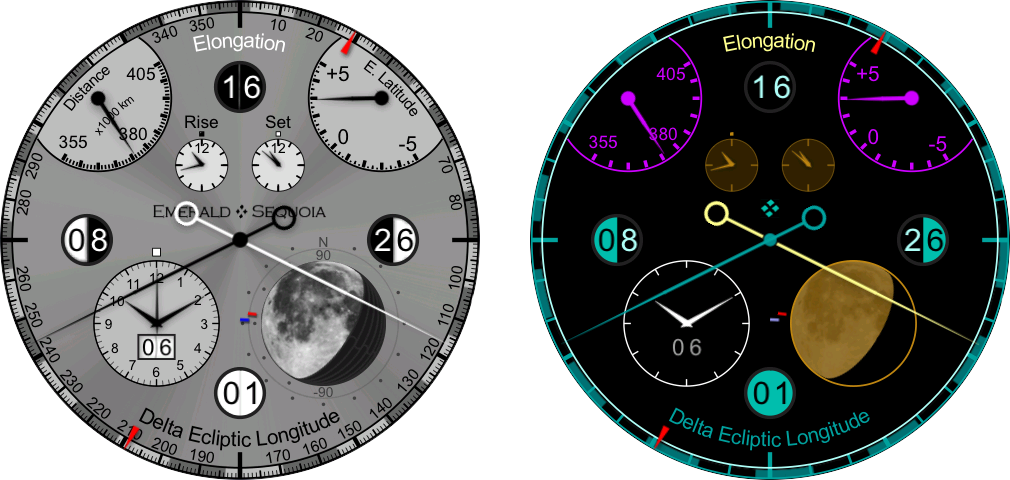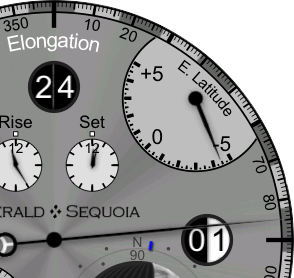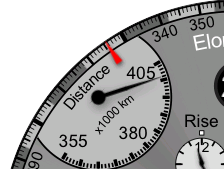
| Buy this face |

|
| Buy all 21 faces |

|

| Buy this face |

|
| Buy all 21 faces |

|
Selene (Greek goddess of the Moon) shows the phases of the Moon.
The main black hand indicates the difference between the Moon's ecliptic longitude and the Sun's; this is a representation of the Moon's cycle through the phases. Straight up is new moon (0 age), at right is first quarter (about 7.5 days old), straight down is full moon (about 15 days), left is 3rd (last) quarter (about 22 days old). A complete lunar cycle is about 29.5 days (though it actually varies by several hours from month to month).
Underneath the black hand is a white "Elongation" hand showing the angular separation between the Sun and the Moon in the sky. Note that for most of the time as the Moon increases from New to Full (the right half of the dial), the elongation is very close to the value of “Delta Ecliptic Longitude” (or moon phase) shown by the black hand, and the white elongation hand will be “hiding behind” the black hand. But when the elongation is close to 0 or 180 degrees, and the Moon’s ecliptic latitude is not close to zero, the elongation will be different enough for the hand to “peek out”. And during the waning cycle from Full to New (the left side of the dial), the two hands are on opposite sides of the dial and will both be clearly visible, as shown in the images at the top of this page.
When the angular separation is less than about 90 degrees, we calculate it using the positions of the Sun and the Moon as seen from the observer’s position (topocentric coordinates), as that is most useful when the objects are close together. When the angular separation is larger than that, we switch to using the positions as seen from the center of the Earth (geocentric coordinates), as that is most useful close to a full moon where there is the possibility of a lunar eclipse (the shadow thrown by the Earth is centered at the Earth center, and doesn’t depend on the observer’s position).
The outermost dial with the degree markings for the previous two hands is colored alternately dark and light. Each dark or light section represents a 24-hour day, so you can easily count how many days until the next quarter by counting sections from the main black hand to the quarter's indicator. You can also estimate the approximate time of day that quarter will occur by seeing where in its colored section it lies (if the main black line for the quarter is close to the forward part of its colored section, the event will happen late in that day).
These sections are accurate for nearly a full lunar cycle centered around the current time. That is, you can count sections, forward or backward from the main black hand, for 14 days in each direction, which will be just under half a lunar cycle.
 The numbers in the quarter icons show the date when that phase occurred or will occur.
The two clockwise from the main hand are in the future, and the two behind the main hand show dates in the past. The main black hand passes over the indicator on the date shown.
Frequently the dates are in different calendar months; in example at left for 2020 Feb 1
the previous new moon was on Jan 24 and the next 1st quarter moon will be Feb 1 later in the day
and the Moon is about 85 degrees east of the Sun.
The numbers in the quarter icons show the date when that phase occurred or will occur.
The two clockwise from the main hand are in the future, and the two behind the main hand show dates in the past. The main black hand passes over the indicator on the date shown.
Frequently the dates are in different calendar months; in example at left for 2020 Feb 1
the previous new moon was on Jan 24 and the next 1st quarter moon will be Feb 1 later in the day
and the Moon is about 85 degrees east of the Sun.
The small dial at 2 o'clock shows the Moon's ecliptic latitude (which is its angular difference from the Sun in the dimension perpendicular to the longitude). The ticks on the dial represent 1 degree, about twice the apparent diameter of the Moon. When the hand is at the plus side the Moon is north of the Sun. In the example at the left the Moon is about 4.5 degrees south of the ecliptic.
 The small dial at 10 o'clock shows the distance from the center of the Earth to the center of the Moon (in thousands of kilometers). The example at the left shows a value of about 401,000 km.
The small dial at 10 o'clock shows the distance from the center of the Earth to the center of the Moon (in thousands of kilometers). The example at the left shows a value of about 401,000 km.
At the bottom left is a dial showing the current time, including the day of the month in a window. In the top center are dials showing moonrise and moonset for the current day; a small dot above each is white for AM, black for PM, and red if there is no such event on this day.
At the bottom right is a Moon phase dial like that of Chandra. Just outside the circle of that dial are two additional hands: the red inner one displays the altitude of the Moon from -90 to 90 degrees, and the blue outer one displays the azimuth.
The two thin red triangle hands on the main dial represent the "nodal" points of the Moon's orbit. These are the two points where the Moon's ecliptic latitude is zero, as the Moon cycles above and below the plane defined by the Earth's orbit around the Sun. The position of each hand indicates the delta ecliptic longitude (with respect to the Sun) of that nodal point, so that when the black hand passes over a red nodal point marker, the ecliptic latitude is zero at that time. The nodal markers (unlike the nodal hands on Basel) make a full revolution approximately once per year, as the ecliptic longitude of the Sun makes a similar revolution.
When a nodal marker and the main black hand are both near zero (new moon), a solar eclipse is possible. When both near 180 degrees (full moon), a lunar eclipse is possible.
In ambient mode, the same information is displayed with different colors to save energy. In particular, the Delta Ecliptic Longitude is aqua (matching its label at the bottom of the dial) and the Elongation hand is yellow (matching its label at the top).